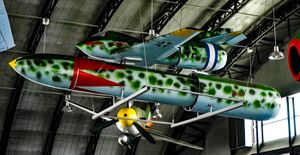Engineering:Blohm & Voss P 214
| P 214 | |
|---|---|

| |
| Role | Single-seat dive bomber |
| National origin | Nazi Germany |
| Manufacturer | Blohm & Voss |
| Designer | Richard Vogt |
| Status | Design project |
The Blohm & Voss P 214 was a small manned powered bomb project with a large warhead mounted integrally with the fuselage, designed in late 1944 but not developed past the project stage.
Officially this project was known in German as Bemannte Fla. Bombe (Fla. standing for Flugabwehr), meaning "Manned Air Defence Bomb".[1]
Design
The P 214 would have been carried as a parasite aircraft by a mother plane to an altitude above the enemy bomber fleet. Then the pilot would have put the aircraft into a steep dive in order to deliver a strong explosive charge. Once the aircraft was well-aimed at the target the pilot should have bailed out, letting the unmanned plane explode in the middle of the enemy bombers.[2] However, even though it was theoretically feasible for the pilot to escape, in practice the chances were next to nil.[1]
Although it was not intended as such, owing to the real dangers for the pilot inherent in the operation of this dangerous aircraft, the P 214 is sometimes listed as a suicide weapon.[1]
Replica
An exhibit on display at the Military Aviation Museum in Virginia Beach, Virginia is claimed to be a replica.[3]
Specifications
Data from [2]
General characteristics
- Crew: 1
- Length: 6 m (19 ft 8 in)
- Wingspan: 5 m (16 ft 5 in)
- Wing area: 10 m2 (110 sq ft)
- Gross weight: 3,600 kg (7,937 lb)
Performance
Armament
- Bombs: 1x 2,204 lb (1,000 kg) warhead
See also
- Emergency Fighter Program
Aircraft of comparable role, configuration and era
Related lists
References
- ↑ 1.0 1.1 1.2 Ulrich Albrecht. "Artefakte des Fanatismus; Technik und nationalsozialistische Ideologie in der Endphase des Dritten Reiches". Wissenschaft & Frieden 1989-4. http://www.wissenschaft-und-frieden.de/seite.php?artikelID=0833. Retrieved 22 March 2017.
- ↑ 2.0 2.1 Nowarra, Heinz J. (1993) (in German). Die Deutsche Luftruestung 1933-1945 Vol.1 - AEG-Dornier. Koblenz: Bernard & Graefe Verlag. p. 142. ISBN 978-3-7637-5464-9.
- ↑ "Blohm & Voss P-214 'Mistletoe' Rocket Bomb, Military Aviation Museum, Virginia Beach - a photo on Flickriver". http://www.flickriver.com/photos/petercookuk/18386218646/.

